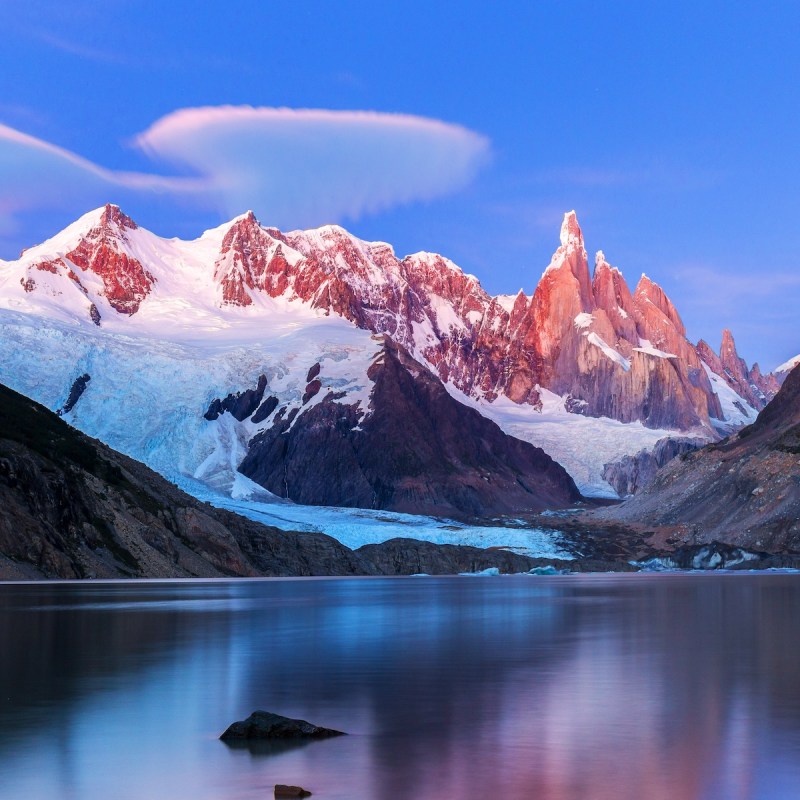
When planning a trip to Patagonia, either on the Chilean or Argentine side (or both), it is nearly impossible not to visit a national park. This southernmost region of the South American continent is riddled with parks, many of which are must-explore national parks. These are the parks that come to mind when people think of Patagonia. Below you will find my top five must-visit national parks in Patagonia.
Videos by TravelAwaits

1. Torres Del Paine National Park
These are the three imposing peaks that look like towers and you can see them on nearly every postcard from Chilean Patagonia. These are likely the towers that first drew you to Patagonia. This is the park that any visit to Patagonia is not complete without. It is any adventurer’s dream.
If you are visiting Patagonia and only going to visit one place, it will very likely be Torres del Paine, and with good reason. First, it is visually stunning with a vast and dramatic landscape covering over 1,120 miles of forest, complete with glacial lakes, crazy rock formations, and miles and miles of trails.
Most famous in Torres del Paine are the two hikes that take you up close and personal with the famous towers. There’s the Paine Circuit which is the longer, yet less strenuous of the two main hikes. It will take you 7–10 days depending on how many rest days you take or side trips you make.
If this does not fit into your schedule, there is also the famous W hike, the shorter (5 days) but more strenuous of the hikes to the towers. It is named after the shape of the route. Both hikes have strategically placed refugios (rustic shelters in campsites) along the way, but keep in mind, these are basic and you must bring all food and equipment with you the length of the hike.
If you’re not up for a lengthy trek or are limited on time, a day visit to the park is still well worth it. There are several other shorter trails that allow you to enjoy the magic that is Torres del Paine National Park.

2. Pumalin National Park
This park was formerly called simply Pumalin Park and was the dream of American businessman (co-founder of both North Face and Esprit clothing lines) Douglas Tompkins and his wife Kristine. When I lived in Chile, it was the subject of much controversy amongst Chileans who worried that any foreigner owning so much land (over 1,000 square miles) was never a good thing. At the time, it was the world’s largest private nature reserve.
However, I was thrilled to learn in my research for this article that the park has since been donated to the Chilean government in 2017. It then became a national park and one of the largest in all of South America.
Because of its size, some of this park is only accessible by boat — either a cruise or a multi-day kayak excursion. There are treks and hikes of all sorts of lengths sure to please any trailblazer. There are also lots of campgrounds and cabins on the southern side from which to do day hikes or longer treks.
Along with its vast size, Pumalin is also known for its diversity, both in wildlife and terrain. On any given day, you might spot herds of guanaco (a deer-like animal similar to a llama), a flock of flamingos, or a flock of rheas (an emu-like bird). As far as terrain goes, you might find yourself hiking among grasslands, astride rivers, or wetlands.
3. Patagonia National Park
This is one I’ve not visited because it is a rather new park (2018) in the Aysen region of Chile. It is pretty uncommon that there might be new parks that come about, given that they usually come about in an effort to conserve the landscape and wildlife. However, I felt I had to mention this one as it is again the work of Kristine Tompkins.
Often called the “Serengeti of the Southern Cone” for its diversity in wildlife, this new national park is one to check out. Be sure to keep an eye out for Chile’s national bird, the Andean condor. They are truly a sight to see soaring high above. As for its landscape, Patagonia National Park is full of gorgeous glacier-fed lakes, wetlands, and mountains.

4. Los Glaciares National Park
Moving onto the Argentine side of Patagonia brings us to Los Glaciares National Park. This is Argentina’s largest national park at over 2,800 square miles and it is commonly divided into two parts. Accessed from the quaint town of El Calafate (from which all sorts of excursions and equipment can be booked or rented), the southern region of the park is home to the famous glacier — Perito Moreno. This is the world’s largest advancing glacier and is accessible by land or a boat tour from the park.
Heading to the northern side of the park brings you to the famous Mount Fitz Roy. While not so famous for its height, it is famous for being one of the most difficult peaks to climb and brings climbers from around the world eager to make it to the top. I cannot tell you how many folks I came across in my travels in Patagonia whose main goal was to summit that peak.
This northern side is accessed from the town of El Chalten. This is another small town that will have all you need to book or rent your excursions or equipment. Given its size, you will likely want to decide which side you’d like to visit if your time is limited. This will likely be decided by whether you’re keen on glaciers or climbing difficult peaks.

5. Tierra Del Fuego National Park
Located at the “end of the world” in Ushuaia, Argentina, Tierra del Fuego, or “The Land of Fire,” is the southernmost national park in Argentina. It also may well be my favorite of all the parks I visited on either side, but this might be due to the week I had to explore it.
Along with jagged peaks and subarctic tundra, this park also has a beautiful coastline along which many trails take you. My favorite trail of the several I hiked during my week, while waiting for an Antarctic-bound ship, was one that actually had me cross into the country of Chile. There was only a small sign to alert hikers to this fact and on top were coins of either country — a way to keep tally. It was, without a doubt, the easiest border crossing I’ve ever made.
In my week waiting for my ship to sail, I never walked the same trail twice. Tierra del Fuego is full of paths ranging from easy to difficult, so it’s a breeze to find a trail that suits your ability.
With so many scenic and unique national parks to choose from on your Patagonian adventure, you are sure to find everything you are seeking. Be prepared for the weather to change often and dress in layers. Keep in mind that even in the South American summer, the further south you get, the colder you will be.
Related Reading:

